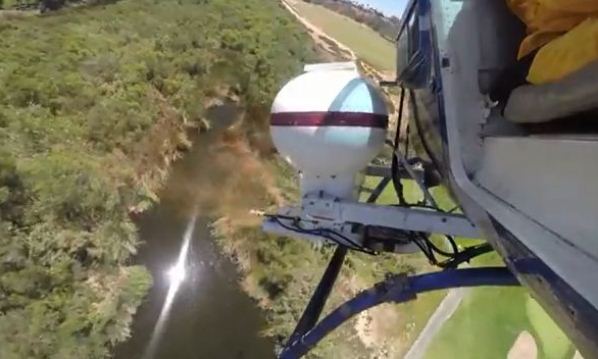By Gig Conaughton, County of San Diego Communications Office
San Diego County’s Vector Control Program is scheduled to conduct a routine mosquito-fighting, aerial larvicide drop Thursday on more than 30 rivers, streams, ponds and other waterways to kill mosquito larvae.
In addition, Vector Control officials are also reminding residents they need to find and dump out all standing water in and around homes to keep mosquitoes from breeding around them.
The County has been using helicopters to drop batches of solid, granular larvicide on local waterways roughly once a month, from April or May through October, for the past 15 years to fight West Nile virus.
West Nile virus is mainly a bird disease that can be transmitted to people by Culex mosquitoes native to San Diego County if they first bite an infected bird or animal and then feed on people. In addition to the aerial larvicide drops, County Vector Control treats another roughly 1,400 potential mosquito-breeding areas by hand, gives out free mosquito-eating fish, tracks down and treats neglected swimming pools, tests dead birds for West Nile virus and monitors cases for other potential mosquito-borne illnesses.
Roughly eight out of 10 people who become infected with West Nile virus never know it and never suffer any symptoms. Most of the remaining 20% percent suffer mild, flu-like symptoms, but in rare cases, West Nile virus can be deadly.
Three San Diego County residents have tested positive for West Nile virus this year, but all of them contracted the virus outside of San Diego County. All three were hospitalized but discharged.
Public Plays a Part
Starting in 2014, County Vector Control has found new types of invasive mosquitoes in the county that like to live and breed around people, in backyards and even inside homes, rather than the waterways covered by the County’s larvicide drops. Those mosquitoes have made it more important than ever for residents to find and dump out standing water in and around homes to keep them from breeding and biting people.
Three types of invasive Aedes mosquitoes have been found here: Aedes aegypti, also known as the yellow fever mosquito; Aedes albopictus, also called the Asian tiger mosquito; and Aedes notoscriptus, also known as the Australian backyard mosquito and the “Aussie Mozzie.”
These mosquitoes are native to more tropical parts of the world, including Australia, Africa, Southeast Asia and South and Central America. They are capable of transmitting diseases like Zika, dengue and chikungunya to people. However, because those diseases are not normally found here, local transmission is highly unlikely. People would have to travel to other parts of the world, become infected, come to San Diego while still infected, and then get bitten by invasive Aedes mosquitoes here that could bite and infect other people.
Invasive Aedes mosquitoes, however, are still a pest. They are aggressive biters and people are their main food source. Unlike most mosquitoes native to San Diego County, invasive Aedes like to bite people during the day, including dusk and dawn, rather than during the night. And they can lay eggs in very small amounts of water, as small as a bottle cap.
County Vector Control officials said people can help by following the County’s “Prevent, Protect, Report” guidelines:
Prevent mosquito breeding
Dump out or remove any item inside or outside of homes that can hold water, such as plant saucers, rain gutters, buckets, garbage cans, toys, old tires, and wheelbarrows. Mosquito fish, available for free by contacting the Vector Control Program, may be used to control mosquito breeding in backyard water sources such as unused swimming pools, ponds, fountains and horse troughs.
Protect yourself from mosquito bites
Protect yourself from mosquito-borne illnesses by using insect repellent when outdoors, or by wearing long sleeves and pants. Use insect repellent that contains DEET, picaridin, oil of lemon eucalyptus, or IR3535. Make sure screens on windows and doors are in good condition and secured to keep insects out.
Report possible mosquito activity
Report increased mosquito activity or neglected, green swimming pools and other mosquito-breeding sources, as well as dead birds — dead crows, ravens, jays, hawks and owls — to environmental health’s Vector Control Program by calling (858) 694-2888 or emailing vector@sdcounty.ca.gov. Also report if you are being bitten by mosquitoes during daylight hours, or if you find mosquitoes that match the description of invasive Aedes mosquitoes by contacting the Vector Control Program at (858) 694-2888.
For more information about mosquito-borne illnesses, go to San Diego County’s “Fight the Bite” website.
Gig Conaughton is a communications specialist with the County of San Diego Communications Office. Contact



















